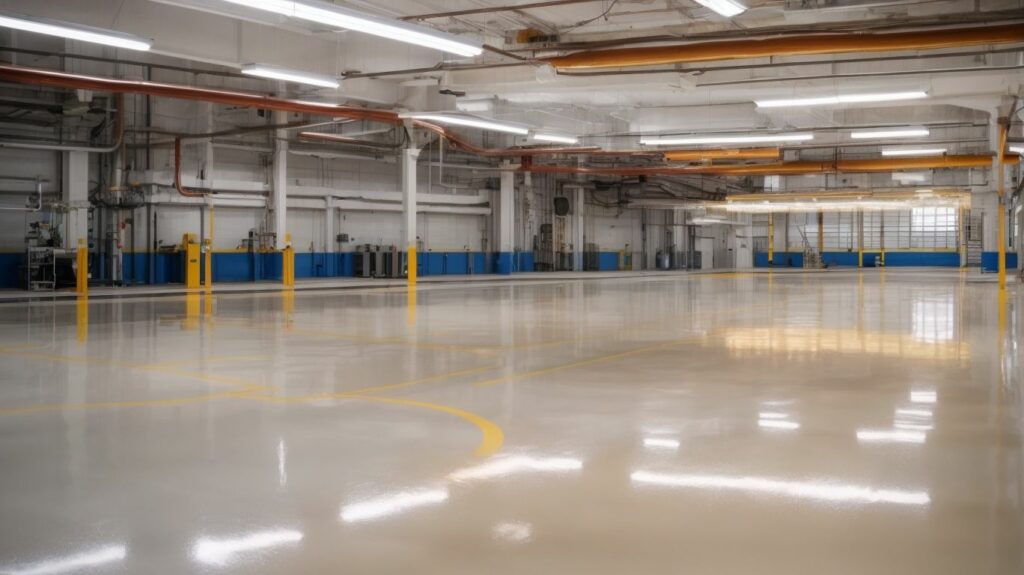24+ Years Experience
Specialist Epoxy Resin Flooring

Enquire Today For A Free No Obligation Quote
plaintext
Epoxy resin flooring is a popular choice for both residential and commercial spaces due to its durability, versatility, and aesthetic appeal. However, the installation process requires careful attention to detail to avoid common mistakes that can compromise the integrity and longevity of the flooring. Here are some key aspects to consider, as suggested by reputable sources like The Flooring Guide:
Common Mistakes to Avoid during Epoxy Resin Flooring Installation:
To ensure a successful epoxy resin flooring installation, remember the following tips:
By being aware of these potential pitfalls and following these tips, you can avoid common mistakes and achieve a successful epoxy resin flooring installation that meets your expectations in terms of both aesthetics and performance.
Epoxy resin flooring offers numerous benefits that make it a popular choice for both residential and commercial spaces. Here are some reasons to choose epoxy resin flooring:
Epoxy resin flooring provides a durable, low-maintenance, and customizable flooring solution for various applications. If you’re looking for a long-lasting and visually appealing flooring option, epoxy resin flooring is a great choice.
Don’t let your epoxy resin flooring installation turn into a sticky situation! This section provides valuable information on the common mistakes to avoid during epoxy resin flooring installation. From inadequate surface preparation to inaccurate epoxy resin application and overlooking maintenance requirements, we will guide you to steer clear of these pitfalls. With facts and reliable sources, we will show you how to achieve a flawless epoxy resin flooring that will leave you walking on cloud nine.
Inadequate surface preparation is a common mistake to avoid during epoxy resin flooring installation. Properly preparing the surface is crucial for ensuring the adhesion and longevity of the epoxy coating. Neglecting this step can result in issues such as peeling, bubbling, or premature wear. To avoid this mistake, it is important to thoroughly clean the surface, removing any dirt, grease, or previous coatings. Additionally, any cracks or imperfections should be repaired, and the surface should be ensured to be dry and free of moisture. Proper surface preparation lays the foundation for a successful epoxy resin flooring installation.
Improper mixing of epoxy resin components can result in poor adhesion, weak bonds, and an uneven finish. To ensure a successful installation of epoxy resin flooring, it is important to follow these steps:
Carefully read the manufacturer’s instructions to determine the correct ratio of resin and hardener.
Accurately measure the components using calibrated measuring tools.
Pour the measured resin and hardener into a clean mixing container.
Thoroughly mix the components together using a stir stick or paddle mixer.
Continue mixing until the mixture is uniform in colour and consistency.
Avoid introducing air bubbles by stirring slowly and scraping the sides of the container.
Use the mixed epoxy resin within the recommended pot life to ensure proper curing.
Apply the resin to the prepared surface following the application technique specified by the manufacturer.
Allow the epoxy resin to cure undisturbed for the recommended curing time.
True story: One contractor neglected to properly mix the epoxy resin components and ended up with a floor that had weak spots and delamination issues. It was a costly mistake that could have been avoided with careful attention to the mixing process.
Insufficient drying time during epoxy resin flooring installation can result in various problems. To ensure proper drying, follow these steps:
Inaccurate application of epoxy resin can result in unsatisfactory outcomes and a compromised flooring system. To ensure a successful installation of epoxy resin flooring, it is important to follow these steps:
One important mistake to avoid when installing epoxy resin flooring is failing to address moisture issues. Moisture can have a negative impact on the adhesion and performance of the epoxy resin, resulting in problems like bubbling, peeling, or discolouration. It is essential to thoroughly assess the moisture levels in the substrate before installation and take appropriate measures to resolve any issues. This may involve using moisture barriers or moisture-resistant primers, ensuring adequate ventilation, or addressing underlying sources of moisture. By effectively dealing with moisture problems, you can ensure the longevity and durability of your epoxy resin flooring. Take proactive measures to prevent any potential moisture-related problems and achieve a successful installation.
Lack of proper ventilation during epoxy resin flooring installation can have negative consequences. Without adequate ventilation, harmful fumes emitted during the installation process can accumulate, posing a risk to the health and safety of individuals in the area. It is essential to ensure that the installation area has proper airflow, either through natural ventilation or the use of mechanical ventilation systems. This will help to dissipate the fumes and create a safe environment. Remember, prioritising proper ventilation not only protects those involved in the installation but also promotes a higher quality installation.
Fun Fact: Did you know that epoxy resins have been used in various industries for over 70 years due to their excellent adhesive and protective properties?
Ignoring safety precautions during epoxy resin flooring installation can lead to serious accidents and health hazards. It is crucial to prioritise safety measures to protect yourself and others involved. Some essential safety precautions to consider are wearing appropriate personal protective equipment, ensuring proper ventilation in the working area, and following all manufacturer’s instructions for handling and applying the epoxy resin. It is important to be aware of any potential hazards, such as slippery surfaces or fumes, and take necessary measures to minimise the risks. By disregarding safety precautions, you not only put yourself in danger but also compromise the quality and durability of the resin flooring.
Overlooking maintenance requirements for epoxy resin flooring can result in premature deterioration and expensive repairs. It is essential to prioritize regular cleaning and maintenance to preserve the quality and lifespan of the flooring.
| Maintenance Requirements | Description |
| Regular Cleaning | Remove dirt, debris, and stains using mild cleaners and non-abrasive tools. |
| Periodic Inspection | Check for any signs of damage, such as cracks or discoloration, and address them promptly. |
| Protective Measures | Use mats or floor protectors to prevent scratches from furniture or heavy objects. |
| Reapplication of Topcoat | Apply a new topcoat as recommended by the manufacturer to maintain the protective layer. |
To ensure the longevity of your epoxy resin flooring, it is crucial to adhere to these maintenance requirements. Regular cleaning, inspections, and protective measures will help prevent damage and keep the flooring in optimal condition. Remember to consult the manufacturer’s instructions for specific maintenance recommendations.
When it comes to the installation of epoxy resin flooring, it is important to avoid common mistakes in order to achieve a successful outcome. In this section, we will provide you with valuable tips that will help you achieve just that. These tips cover various aspects such as surface preparation, proper mixing techniques, drying and curing time, application methods, the use of moisture barriers, ventilation, safety measures, and regular maintenance. Let us now delve into the essential steps and precautions required for a seamless epoxy resin flooring installation.
Before you start installing epoxy resin flooring, it is essential to thoroughly clean and prepare the surface. This is important for ensuring proper adhesion and longevity of the flooring. Follow these steps to effectively clean and prepare the surface:
Pro-tip: Before applying the epoxy resin, make sure that the surface is completely dry to prevent any moisture-related issues during installation.
Using proper mixing techniques is essential for a successful epoxy resin flooring installation. Here are the steps to follow:
Thoroughly read and understand the manufacturer’s instructions.
Gather all the necessary tools and equipment, including measuring cups and mixing containers.
Measure the epoxy resin and hardener in the correct ratio as specified by the manufacturer.
Pour the resin and hardener into a clean mixing container.
Using a stir stick or paddle mixer, blend the components together slowly and thoroughly.
Take note of the recommended mixing time to ensure a proper chemical reaction.
Avoid stirring vigorously to prevent air bubbles from forming in the epoxy.
Scrape the sides and bottom of the mixing container to ensure all components are fully mixed.
Transfer the mixed epoxy into a new clean container and continue with the installation process.
It is crucial to follow these steps precisely to achieve the desired results and maximize the benefits of epoxy resin flooring.
Epoxy resin was first discovered in the early 20th century by a Swiss chemist, Dr. Pierre Castan. He accidentally spilled an experimental compound on the floor of his laboratory and noticed its remarkable adhesion and durability. This led to further research and the development of epoxy resin, which has since been successfully used in various industries, including flooring, for its exceptional strength and chemical resistance properties.
Allowing sufficient drying and curing time is essential for a successful epoxy resin flooring installation. Here are the steps to ensure proper drying and curing:
Epoxy resin flooring has been used for various applications for decades. It was initially developed for industrial use due to its durability and chemical resistance. Over time, epoxy resin flooring has gained popularity in commercial and residential settings due to its aesthetic appeal and long-lasting performance. With advancements in technology and formulation, epoxy resin flooring has become an excellent choice for enhancing the durability and visual appeal of floors.
When it comes to epoxy resin flooring installation, it is crucial to use proper techniques in order to achieve a successful outcome. Here are some steps to follow:
By following these steps and using proper techniques, you can achieve a durable and visually appealing epoxy resin flooring installation.
To address moisture concerns when installing epoxy resin flooring, follow these important steps:
During the installation of epoxy resin flooring, it is important to ensure adequate ventilation in order to promote a safe and successful process. Insufficient ventilation can result in the accumulation of harmful fumes and can compromise the quality of the installation. To ensure proper ventilation, the following steps should be taken:
It is worth noting that adequate ventilation not only improves the installation process, but also contributes to the longevity and durability of the epoxy resin flooring.
To maintain the epoxy resin flooring, it is important to regularly clean and maintain it. Follow these steps:
By following these steps, you can ensure that your epoxy resin flooring remains clean, shiny, and in excellent condition for many years.
It is crucial to follow the manufacturer’s guidelines for temperature and humidity when installing epoxy flooring. Failure to do so may result in the epoxy not hardening properly or peeling off from the surface.
Common mistakes include not properly preparing the surface before applying epoxy, such as failing to remove wax, oil, or other contaminants. Acid etching or grinding the surface is recommended to ensure a strong bond.
Stretching epoxy too thin results in a weaker coat, compromising its durability and longevity. It is recommended to purchase an epoxy kit that offers more coverage than the area you need to cover.
To prevent air bubbles from forming in the epoxy coating, it is important to mix the epoxy slowly and carefully. Rushing the mixing process can trap air, creating an uneven finish.
The most common problems include pin holes, bubbles, fish eyes, and a dull finish. These issues can be caused by various factors such as surface debris, outgassing, or overmixing the epoxy material.
Hiring a professional epoxy flooring contractor is recommended to avoid expensive mistakes. They have the necessary training and expertise to properly prepare the floors, choose the right type of epoxy, and ensure optimal performance and durability.






























We Aim To Reply To All Enquiries With-in 24-Hours